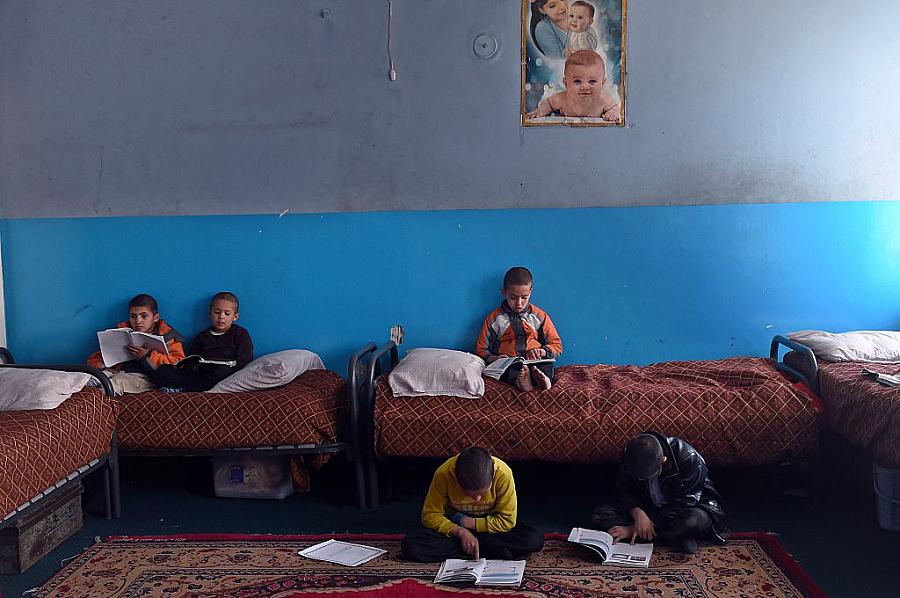COVID is turning millions of children into orphans. A leading early childhood researcher outlines the perils ahead.

(Photo by Wakil Kohsar/AFP via Getty Images)
Among the cruelest legacies of the coronavirus pandemic are the orphans the virus has left in its wake. More than 7.5 million children have been orphaned since it began, according to Imperial College London.
Losing a parent is an incalculable loss for a child anywhere, but the fallout is far greater for kids forced into institutional care as a result, a practice that still prevails in many parts of the world.
Perhaps no one knows more about the science of what happens to young brains when institutionalized than Charles Nelson, a professor of pediatrics and neuroscience at Harvard Medical School, who spoke to 2022 National Fellows remotely this week via Zoom, despite fending off a bout of COVID.
Institutional care amounts to “an extreme form of neglect,” Nelson told journalists, and the practice remains widespread globally. Estimates vary widely, but up to 8 million kids are raised in institutions around the world. He compares the developing brain to a computer waiting for instructions: The only thing worse than giving it software full of faulty code (a childhood marked by adversity) is giving it no code at all (the extreme neglect that is a hallmark of bad institutional care). In that case, the brain has no idea what to do, he said.
“The worst thing you can do to a developing brain is to deprive it of experience,” Nelson said, noting that many orphanages around the world inadvertently do just that.
Nelson and his colleagues started their long journey of demonstrating this decades ago in a landmark study of Romanian orphans called the Bucharest Early Intervention Project. In the early 2000s, researchers identified and screened 136 young children in Bucharest before randomly assigning them to two groups: Half were placed in high-quality foster care, while the other half remained in orphanages. Both groups were then assessed at regular intervals, continuing to this day — 21 years later.
The differences in the children’s brains and well-being soon became clear: On everything from measures of IQ to brain development and activity to mental disorders, the children in the foster care group fared significantly better than their peers. The age at which kids were placed in foster care was important as well: Children removed from institutions and placed in foster care before age 2 had higher IQs than kids placed later, according to Nelson.
The differences in the two groups persisted over time. Even at age 18, there was a nine point IQ difference between the foster care and institutional groups.
What’s the biggest factor that can explain the difference between the two groups? “The secret ingredient is the quality of care,” Nelson said. “The better the quality of care, the higher the IQ of the child.”
(On a more somber note, even though the children moved to foster care tested significantly higher than kids in institutions on various measures of brain development, their scores were consistently lower than children that had never spent any time in institutions. Nelson says those differences might have been eliminated if the kids had entered foster care earlier.)
There were also lasting differences in mental health, not just cognition and brain development. The children stuck in institutional care had high rates of mental health problems that persisted or grew as they aged. The foster care kids showed declines over time. The divergence was even starker when it came to what psychologists call “externalizing behaviors,” such as getting into fights and acting out. These behaviors increased over time in the institutional group, while foster care kids showed declines over time. The researchers have also found more recently that the behavior of children in institutions is more impacted by stress.
“Growing up in an institution sensitizes you to stressful life events,” Nelson said.
The study had a major and rapid impact. Two years into the project, in 2002, the researchers held a press conference in Romania to announce their findings to the government, which had previously maintained that orphanages were the best option for these children. The country had not had a foster care system. A couple years later, the country passed legislation banning the practice of placing young children under the age of 2 in institutions. UNICEF, the European Union and the World Health Organization have also leaned on the research to urge other governments to stop institutionalizing children around the world, according to Nelson.
But the growing numbers of COVID orphans has ushered in a fresh crisis of global proportions, as Susan Hillis and Seth Flaxman wrote this spring in an opinion piece for STAT. The pair of researchers argue that the United States should build “on the success of U.S. governmental programs like the President’s Emergency Plan for HIV/AIDS Relief that have provided support for 20 years to the millions of children orphaned by AIDS.” Some programs can, among other things, “invest in family-based support services to keep children in loving families and out of orphanages.”
Global crises such as the pandemic and wars only exacerbate the problem. Even before the war broke out, 1% of children in Ukraine were being raised in institutions, Nelson said. And border detention centers replicate many of the worst aspects of institutional care.
“The bottom line is if you can’t prevent exposure to adversity, you have to intervene as early in life as possible.”
**

